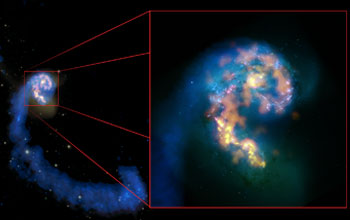All Images
News Release 11-212
ALMA Opens Its Eyes
Humanity’s most complex ground-based astronomy observatory opens for business
This material is available primarily for archival purposes. Telephone numbers or other contact information may be out of date; please see current contact information at media contacts.

This multiwavelength image of a colliding pair of spiral galaxies, called the Antennae, displays a history of star making. The gravitational upheaval of two, large, dense spirals merging into each other destroys the shapes of the two galaxies and smashes gas and dust clouds into new star-forming regions.
The star- and gas-filled tidal tails are seen here as long, insect-like antennae. The older stars in them shine in pale white, and the gas glows in radio waves shown in this image as blue. (Radio images from the Very Large Array at 21cm. Wide field optical images from 0.9-m at Cerro Tololo Inter-American Observatory.) Orange and yellows represent ALMA's millimeter/submillimeter wave test views.
Credit: (NRAO/AUI/NSF); ALMA (ESO/NAOJ/NRAO); HST (NASA, ESA, and B. Whitmore (STScI)); J. Hibbard, (NRAO/AUI/NSF); NOAO/AURA/NSF.
Download the high-resolution JPG version of the image. (585 KB)
Use your mouse to right-click (Mac users may need to Ctrl-click) the link above and choose the option that will save the file or target to your computer.
Dr. Kartik Sheth and Dr. Adam Leroy of the NRAO's North American ALMA Science Center, and Dr. Brad Whitmore of the Space Telescope Science Institute explain how ALMA will contribute to our understanding of the universe.
Credit: National Science Foundation
In this video you can see ALMA at its 16,500 ft elevation site in northern Chile. Despite the fact that it is still under construction, ALMA is the most powerful telescope of its kind in the world. For the start of Early Science, around one third of ALMA's eventual 66 radio telescopes will make up the growing array. Upon completion in 2013, 66 radio telescopes will fan over a nearly 100 square mile area.
Credit: NRAO/AUI/NSF and ALMA (NRAO/NAOJ/ESO)
This is a video simulation of two galaxies colliding.
Credit: Visualization by Frank Summers (Space Telescope Science Institute). Simulation by Chris Mihos (Case Western Reserve University) and Lars Hernquist (Harvard University).

In this zoomed-in image of the Antennae Galaxies, the generation of super bright, hot stars that formed when the denser centers of the two spirals first collided shine in white-blue. The latest stars to light up are ionizing their gas shrouds, making the hydrogen glow bright pink around them. (Optical images from HST ACS/WFC.)
Future stars are growing now, concealed in dark clouds into which optical telescopes cannot see. However, ALMA sees through the obscuring dust and traces of these stellar nurseries, many of which show the continuation of the cloud that has been lit pink by a previous generation of new stars. ALMA's millimeter/submillimeter wave test views here are represented in orange and yellows to contrast with the previous starbirth generations.
Credit: (NRAO/AUI/NSF); ALMA (ESO/NAOJ/NRAO); HST (NASA, ESA, and B. Whitmore (STScI))
Download the high-resolution JPG version of the image. (858 KB)
Use your mouse to right-click (Mac users may need to Ctrl-click) the link above and choose the option that will save the file or target to your computer.

This infographic shows the relative elevations of some famous astronomical observatories, including the new Atacama Large Millimeter/submillimeter Array, for comparison.
Credit: NRAO/AUI/NSF
Download the high-resolution JPG version of the image. (203 KB)
Use your mouse to right-click (Mac users may need to Ctrl-click) the link above and choose the option that will save the file or target to your computer.


